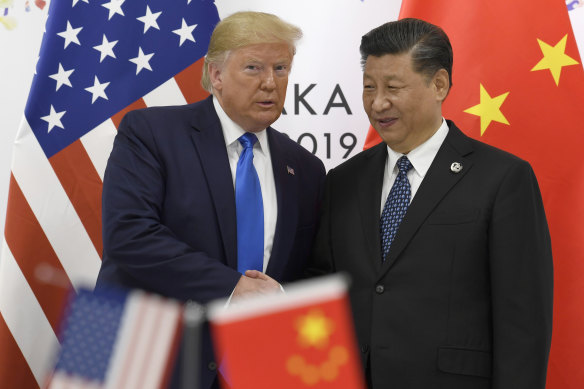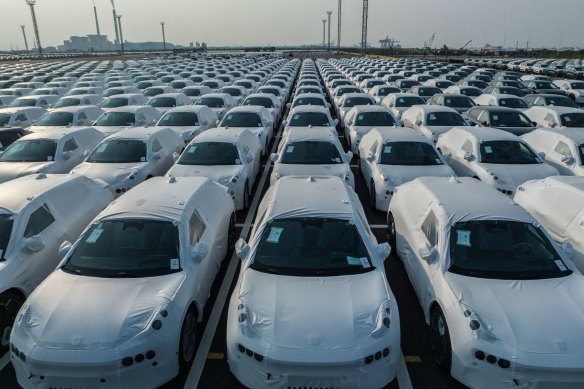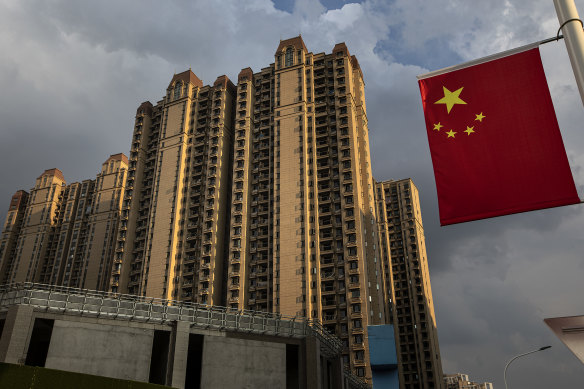This was published 9 months ago
Opinion
Xi Jinping has no plan B as the mood in China darkens
Stephen Bartholomeusz
Senior business columnistWithin the slew of economic data from China released over the past few days there is a tale of two Chinas.
The country’s larger traditional manufacturers are struggling, even as smaller, export-oriented firms are expanding their output. There are also the first signs that President Xi Jinping’s recent emphasis on higher-tech, advanced manufacturing is starting to have an impact.

China’s struggling economy under Xi Jinping would feel further pain if Donald Trump returns to the White House.Credit: AP
That complex picture of China’s industrial base emerged from two sets of manufacturing industry data released at the weekend.
The official National Bureau of Statistics purchasing managers index (PMI) fell from 49.4 in July to 49.1 in August.
Anything below an index reading of 50 indicates contraction, so the fourth consecutive month of a sub-50 reading suggests that growth within the economy continues to weaken.
The private Caixin/S&P Global PMI, however, rose from 49.8 in July to 50.4 in August, which at face value produces a conflicting story of growth.
The Caixin index mostly focuses on smaller export-oriented firms, and that might explain the discrepancies with the official data, which generally reflects the performance of China’s larger companies, which are more exposed to the struggling domestic economy.
China’s export growth has been strong this year – so strong that it has provoked new protectionist responses in the US and Europe.
Even within the Caixin data, however, there was a disconcerting indicator of weaknesses ahead, with new export orders falling for the first time in eight months.
It’s not just that there is increasing agitation in the US and Europe about the swelling tide of cheap exports flooding out of China’s vast manufacturing base.

Xi has showered subsidies and cheap credit on the high-tech sectors he wants China to dominate, such as electric vehicles.Credit: Bloomberg
The US economy, which had been growing more strongly than other developed economies, appears to be slowing, and the eurozone economies are still posting only modestly positive growth numbers, so external demand is weakening.
The data also shows that both input costs and selling prices from the manufacturers have been declining, which fits with the narrative that China’s manufacturing base is laden with overcapacity, leading to discounting and factory price deflation and, given the backdrop of weak domestic demand, the diversion of production to export markets.
Within the overall numbers there were signs that Xi’s efforts to reposition China’s manufacturing base are having an early effect.
While trying to hang onto the old, high-volume, relatively low-tech industrial activities that have powered China’s growth for decades, Xi has showered subsidies and cheap credit on the high-tech sectors he wants China to dominate, such as electric vehicles, semiconductors, artificial intelligence, aviation and green energy.
Subindices in the PMI data showed that the high-tech manufacturing index rose from 49.4 in July to 51.7 in August.
More sophisticated technologies are the key plank in Xi’s long-term economic strategies, but China is experiencing pushback from the US, Europe and other economies.
The US has been cutting off China’s access to the advanced semiconductors vital to most of the new technologies, and has been urging its allies to join it.
The US, Europe and Canada have imposed tariffs on Chinese-made electric vehicles; the US and Canada have increased tariffs on Chinese steel and aluminium; and Europe has a raft of investigations of other Chinese exports under way, including investigations of China’s solar panel and wind turbine exports.
The spectre of Donald Trump also looms large over the Xi strategy, given that he has pledged – should he return to the White House – to impose 60 per cent tariffs on all imports from China (along with a 10 per cent baseline tariff on all other imports).
Xi’s high-tech export-led plans for his economic future would founder if the nation is shut out of the major global markets.
While there have been some modest, quite ad hoc, measures to try to stimulate the domestic economy, Xi doesn’t appear to have a plan B.
He’s resisted the major stimulus programs that external economists have been urging in the post-pandemic years, apparently because he sees any large-scale government spending to stimulate consumption as wasteful.
The wealth effects of China’s property sector implosion – now into its third year – has undermined consumer confidence and household spending and continues to be a drag on economic activity and growth.

China’s property sector continues to sink.Credit: Getty
It’s also destabilised the finances of overly leveraged local governments that were dependent on land sales and property-related income for their revenue.
While Beijing raises most of China’s government revenues, it is those local governments that do most of the spending and that provide community services.
With the property sector continuing to sink – the value of new home sales (in data provided by China’s top 100 real estate companies) fell almost 27 per cent in August from a year earlier, an acceleration from the 19.7 per cent fall in July – the local governments need the help their party leaders promised at their “third plenum” gathering earlier this year.
At the plenum, party officials pledged to give them more “autonomous fiscal capacity”, allowing them to raise more revenue in their own right.
If Trump were to win the presidential election in November and impose his trade policies, the prospect of a global trade war would overwhelm any discussion of whether China’s GDP growth rate this year will have a 5 or a 4 in front of it.
They also decided to establish a “long-term mechanism” for addressing the unsustainable debt levels within local governments’ financing vehicles and to allow the local authorities to raise more funds directly by issuing special bonds.
It would also be helpful if Beijing gave them a bigger share of the revenue it raises.
The embattled and overly indebted local authorities, whose revenues from land sales have fallen another 20 per cent plus over the past year, forcing cuts to spending, are a choke point for the domestic economy.
The authorities in Beijing have tried a range of relatively small-scale measures to try to arrest the decline in the property market, and are reportedly weighing another one, contemplating allowing home owners to refinance their mortgages to lower their borrowing costs.
Effectively, that would transfer value, and cash, from banks to home owners. Whether it would have any material effect on consumption and growth is questionable, given that households, having seen their property-based wealth ravaged, are in deeply defensive mode.
In the absence of a large-scale stimulus program, or an unexpected and significant reversal of the decline in the property sector, Western economists think China will struggle to meet this year’s economic growth target of “around 5 per cent” and that growth next year will be even more subdued.
Its slowdown is obviously not good news for a region, including Australia, that leverages off China’s growth, or for the global economy if the other major economic powerhouse, the US, is also slowing.
If Trump were to win the presidential election in November and impose his trade policies, of course, the prospect of a global trade war would overwhelm any discussion of whether China’s GDP growth rate this year will have a 5 or a 4 in front of it.
The Business Briefing newsletter delivers major stories, exclusive coverage and expert opinion. Sign up to get it every weekday morning.